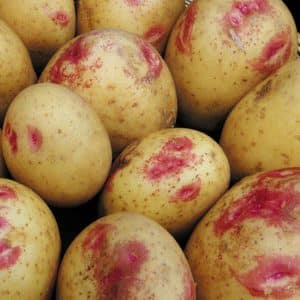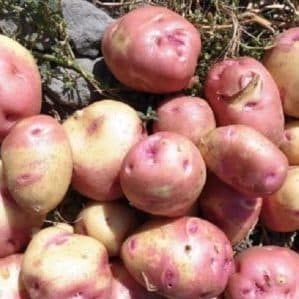Yield, unpretentious and disease-resistant potato variety “Ivan da Marya”
It is curious why the potato variety received such a romantic name - Ivan da Marya. The culture with bright yellow-raspberry tubers is characterized by high yield, excellent taste and unusual coloring of the tubers. All this makes the variety a desirable inhabitant of any garden. Maybe because of this, Dutch potatoes began to be called that by the people?
Features of the variety
In common people the variety is called Matryoshka, Ryabinka, Little Red Riding Hood. And all because of the bizarre color of the tubers.
Origin and development
The Ivan da Marya variety was the result of the renaming of the Dutch potato variety Picasso by domestic breeders. Picasso was created at the end of the 20th century by AGRICO U.A. in the homeland of potatoes - in Holland.
In 1995, the Picasso variety was included in the State Register of Russia and received the popular name Ivan da Marya.
Distinctive features, appearance
It is difficult to confuse the Ivan da Marya potato with another variety: the surface of the tuber crop seems to be painted with an intricate artist’s brush.
The main external differences characteristic of the variety:
- The unusual color of the skin of the tubers is bright crimson eyes and spots on a yellow background.
- Growing season - 110-130 days
- The average starch content is from 7.9 to 13.5%.
- Good keeping quality of tubers - more than 90%.
- Large size of tubers: the average weight of one potato is 100-180 g.
- High vitamin C content, which reaches its maximum during harvest.
- Ability to grow in any region due to the good survival rate of the variety.
Description and characteristics of the plant and crop
The Ivan da Marya bush is formed straight with spreading stems and large dark green leaves. The plant is characterized by large white, lilac-cream inflorescences that quickly fall off. The variety is characterized by large tubers. The skin on the tuber is two-colored - yellow or creamy-raspberry in color. The eyes are crimson, small, in small numbers and unevenly spaced. The flesh is cream-colored.
The variety is considered high-yielding - from 190 to 320 kg of potatoes are harvested from one plot measuring 10x10 m. This is approximately 200-320 c/ha. Each bush usually produces up to 20 medium and large potatoes.
How to grow this variety
In order for the Ivan da Marya variety to please with easy care and an excellent harvest, it is necessary to follow the growing recommendations.
Dates, scheme and rules of planting
Since the variety is late-ripening, in order to ripen the crop on time, it is necessary to first germinate the tubers. This helps to reduce the vegetative period of crop development. The process takes about 30 days, that is, it should begin a month before the intended planting.
The process of germination of Ivan da Marya consists of the following stages:

- Arrange the tubers in one or two layers in a place that provides access to light.
- Maintain a temperature of +20˚С for 10 days to awaken sleeping eyes.
- After the first sprouts appear, maintain the temperature no higher than +15˚C for the remaining time before planting.
- Spray the seed with a weak solution of mineral fertilizer (1-2 times).
In order for the prepared seed to bring a good harvest, it is necessary to turn it over several times during germination - this way the sprouts will form more evenly.
A well-lit area with slightly acidified fertile soil is well suited for planting Ivan da Marya. The area for growing must be prepared in the fall - dig up to a depth of 25 cm and add compost and ash. Soil acidification is especially necessary for soils prone to liming. This is done to prevent fungal scab.
Potatoes are planted when the soil has warmed to a temperature of +8...+10˚С. Usually this time falls at the end of April - beginning of May. The soil should be slightly moistened before planting.
When planting in holes or trenches, it is important to follow the planting pattern. Between holes it is necessary to maintain a distance of 35 cm, and for row spacing - 60-70 cm.
To protect plantings from wireworms, it is recommended to place a handful of ash or onion peels in the hole or trench for planting. To feed the ash and husks, add humus.
At the end they are covered with a layer of soil (8-10 cm).
Attention! Since the roots of the plant are located above the tubers, fertilizer is applied during planting after the tuber is placed in the hole. Otherwise, it will be difficult for the plant to receive nutrients.
Care
Caring for Ivan and Marya is standard and consists of the following steps: irrigation, hilling, weeding, fertilizing.
Irrigation
It is recommended to water as needed: the drier the climate, the more often it is necessary to water. At the same time, it is necessary to avoid excessive waterlogging of the soil - the tubers may rot. The watering regime is determined based on the period when budding begins.
It is preferable to irrigate once a week until buds begin to form and until the potatoes have flowered. Approximate water consumption is 3 liters per bush.It is better to give preference to drip irrigation.
Hilling
During the entire growth period, it is necessary to hill up the potatoes twice.
The first procedure is carried out no earlier than 10-12 days after emergence. The second - after 2 weeks, usually in parallel with the formation of flowers.
Hilling allows you to achieve:
- uniform distribution of moisture in the soil;
- protecting tubers from excessive exposure and greening;
- uniform heating of the soil, preventing caking of tubers in the soil.
In regions where abnormal frosts are possible in summer, the first hilling should be done as soon as the seedlings emerge from the ground, in order to avoid freezing of the plantings.
Weeding
The procedure is carried out as needed, without waiting for the weeds to become tall, and in parallel with hilling. It is advisable to weed the last time after complete vegetative maturation of the tubers.
Attention! The grass not only blocks the sunlight necessary for the development of potato tops, but also draws valuable nutrients from the soil.
Top dressing
Fertilizers contribute twice. The first time - before the formation of buds. Mullein is suitable for this purpose, diluted with water in a ratio of 1:15. It is best to combine it with watering.
The second feeding is carried out when the first flowers appear. Substance used - 3 tbsp. l. superphosphate and 3 tbsp. l. ash - diluted in 10 liters of water. The mixture is also applied to the soil along with watering.
Disease and pest control
Despite its unpretentiousness, Ivan da Marya potatoes are susceptible to diseases and pests.
Colorado beetle
If you miss the appearance of this dangerous pest, you can say goodbye to most of your potatoes in a matter of days.The most popular and effective drugs in the fight against beetles are “Masterpiece” and “Prestige”. You can also use traditional methods: reduce the number of pests by spraying the tops with a decoction of celandine, wormwood or horsetail. Insects cannot tolerate proximity to beans, beans, calendula and marigolds.
Wireworm
So called click beetle larva, which hatches in the weeds and then feeds on the pulp of the potato, leaving winding passages in it. To preserve the harvest, it is recommended to add onion peels to the hole when planting, which are not tolerated by the pest.
Such drugs as “Bazudin”, “Zemlin” and “Pochin” are effective for pest control. The best way to control is to regularly weed the weeds in which the pest larvae live.
Late blight
Fungal disease In a short time it affects large areas of planted potatoes. In the fight against the disease, spraying with “Fitosporin” and preparations containing copper is effective. Treatment must be carried out at least five times from the beginning of potato budding almost until harvest - 10 days before digging.
Leaf roll virus
The disease greatly affects potato yields and leads to the death of plantings. The cause of leaves curling is the ingress of aphids, which attack the leaves and tops. The disease has no cure, so affected bushes should be removed and destroyed.
Collection, storage and use of crops

The variety is late-ripening, so it is recommended to collect it 4 months after planting:
- 2 weeks before the intended digging, cut off the tops at a distance of 15-20 cm above the ground.
- Dig on a warm day to allow it to dry out a little after harvesting.
- It is better to dig up tubers with a pitchfork - this reduces the risk of damage.
After harvesting, the crop is left to dry for 2-4 hours, depending on the weather. The cloudier the sky, the longer the potatoes will take to dry. After this, additional drying is carried out for 1-2 weeks in a dark place. The crops are then sorted for food and planting. Unusable tubers are removed. Selected potatoes are poured to a place prepared for storage.
Attention! Optimal conditions for potato storage - temperature +2...+4˚С and a dry, dark place. At least once a week it is necessary to sort through the crop, getting rid of rotten and spoiled potatoes.
Advantages and disadvantages of the variety
Ivan to Marya, like any variety, has its pros and cons. There are significantly more advantages:
- High yield.
- Good taste.
- High shelf life - more than 90% of the harvest is stored until spring.
- High marketability, which is ensured by an attractive appearance.
- Resistance to the main potato pests and diseases - nematode and cancer.
- Insignificant formation of berries - all the forces of the potato are spent on the formation of tubers.
Flaws:
- Rapid loss of varietal characteristics. Complete degeneration occurs within 4-5 years, so it is recommended to replace the seed material with a new one.
- Poor resistance to late blight, scab and leaf curl.

Growing regions
Ivan da Marya is suitable for cultivation in the Central Black Earth and Central regions, which include the following areas:
- Belgorodskaya;
- Voronezh;
- Kursk;
- Lipetskaya;
- Tambovskaya;
- Vladimirskaya;
- Ivanovskaya;
- Kaluzhskaya;
- Kostroma;
- Moscow;
- Ryazan;
- Smolenskaya;
- Tverskaya;
- Tula;
- Yaroslavskaya.
Farmer reviews
What do those who have already tried to plant Ivan da Marya think? What are their impressions of this potato variety?
Valery, Vologda: “Two years ago I tried to plant the Ivan da Marya variety for the first time after I saw it in the photo. It tolerates drought well, so I water it only twice during the entire season. After each harvest, I make sure to fertilize the area and dig it up. Maybe that’s why these potatoes produce 19 tubers from one bush.”
Nadezhda, Tambov: “I took the variety Ivan da Marya from neighbors for planting. Before that, I had never even imagined that such potatoes existed. Now I only plant it. The taste is good, and the harvest is pleasing. One thing is upsetting: the Colorado potato beetle has become very addicted to the tops. We have to carry out 2-3 treatments with drugs every year.”
Conclusion
Ivan da Marya, due to its characteristics, does not leave negative impressions when grown, therefore it is recommended for planting to everyone who wants to get an unusual and rich harvest. It does not leave indifferent even the most experienced and picky gardener: the unpretentiousness of the variety makes it a welcome guest on the table.